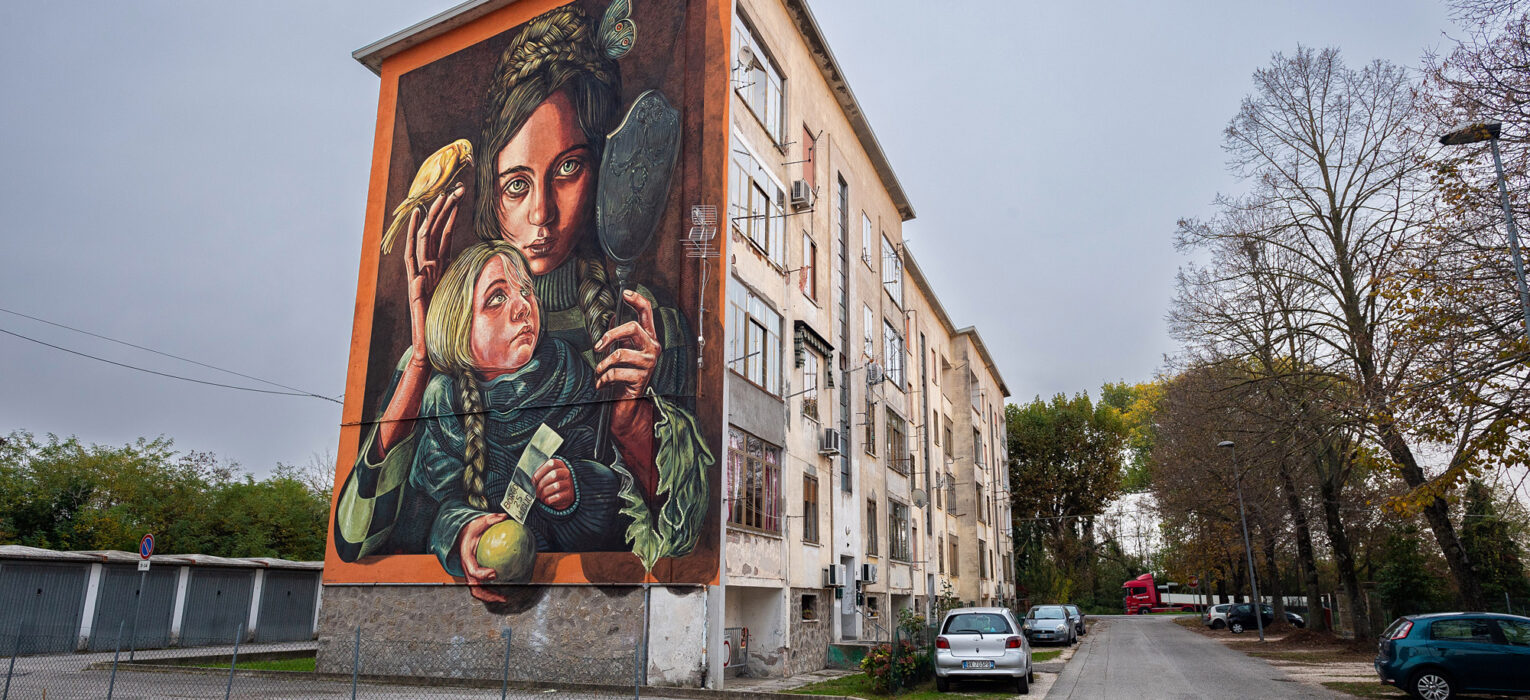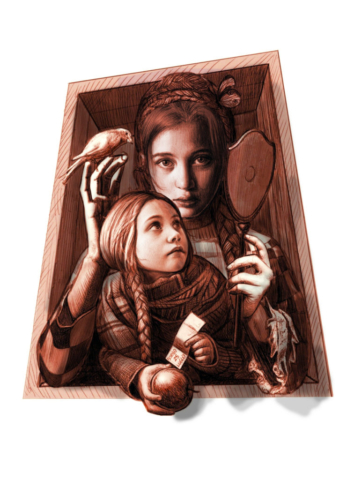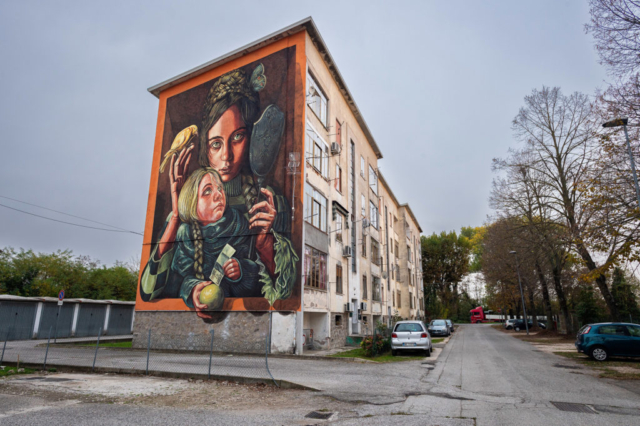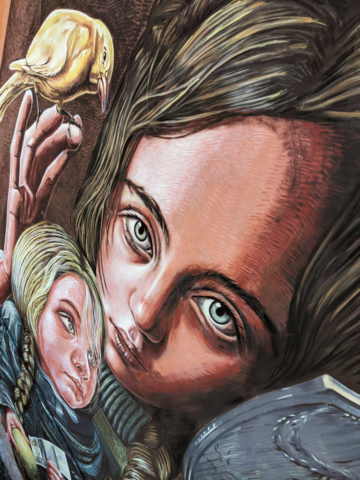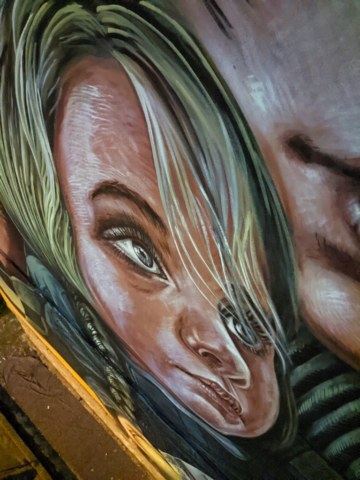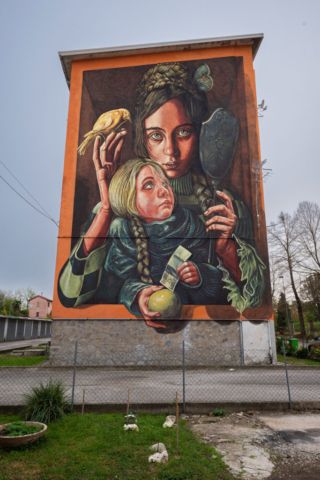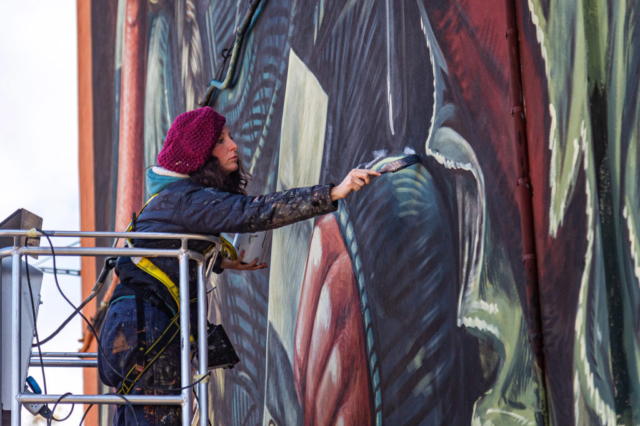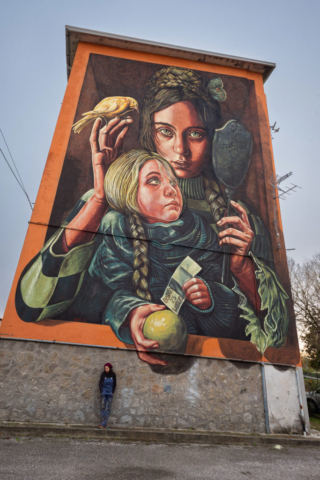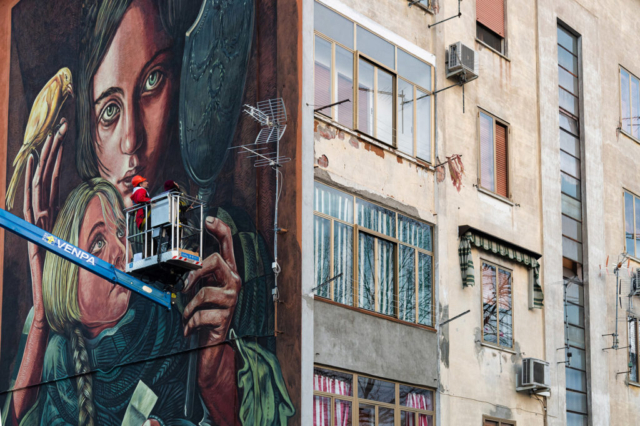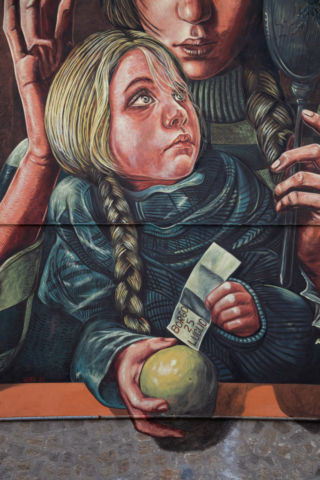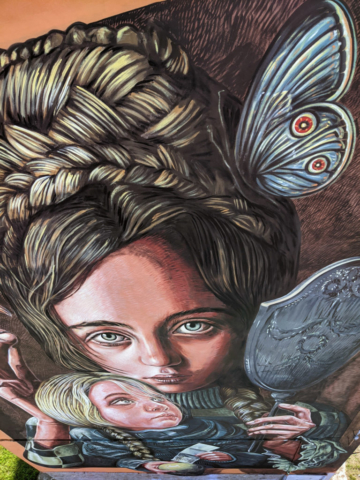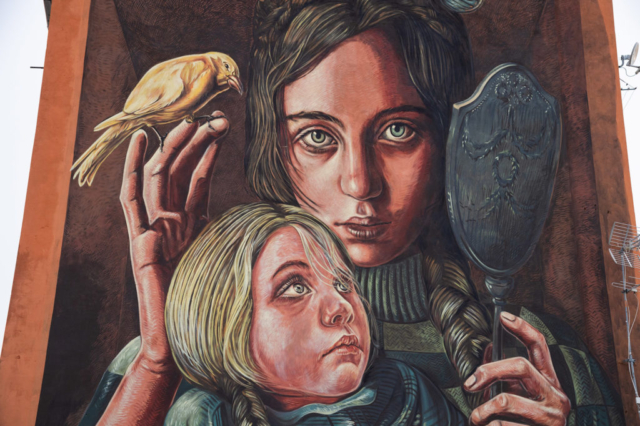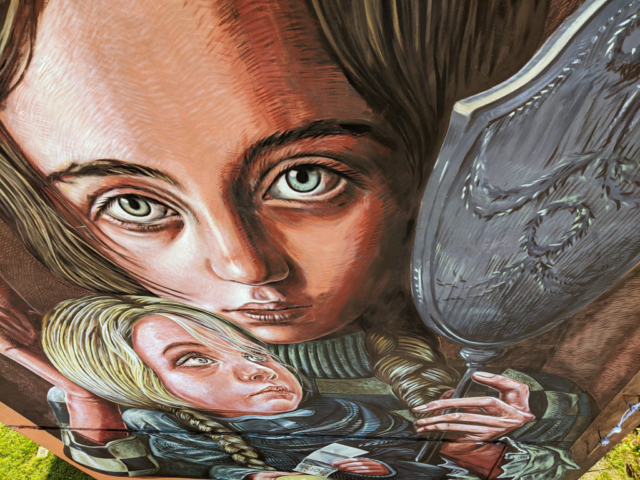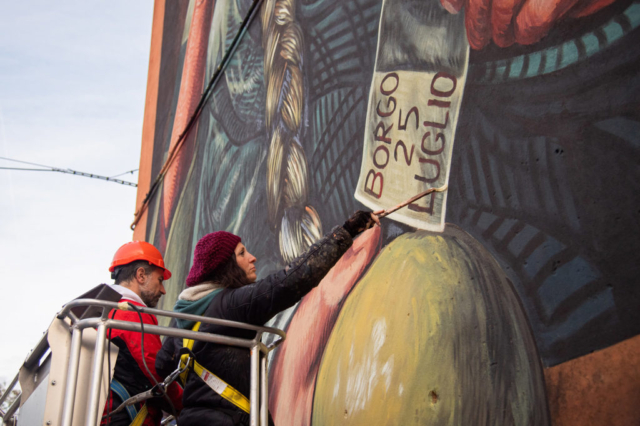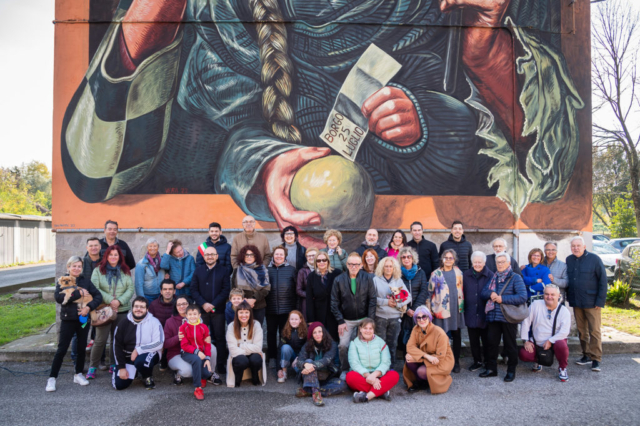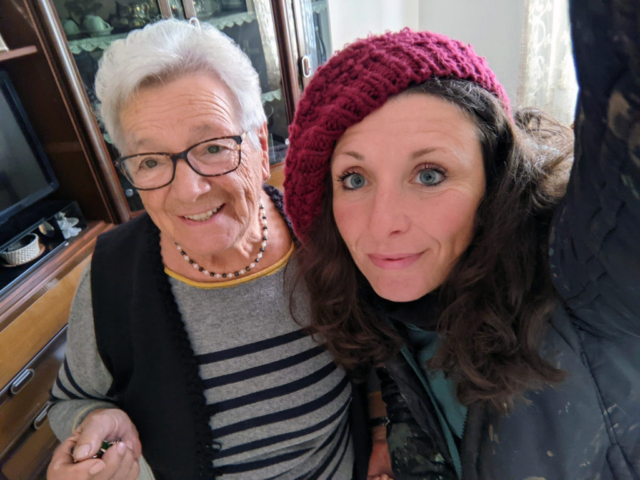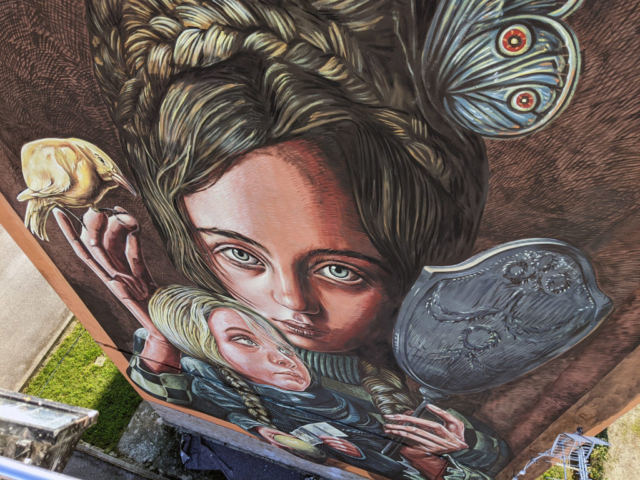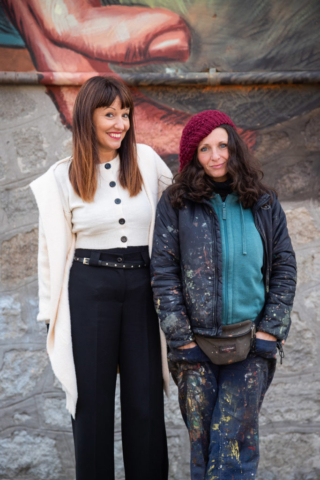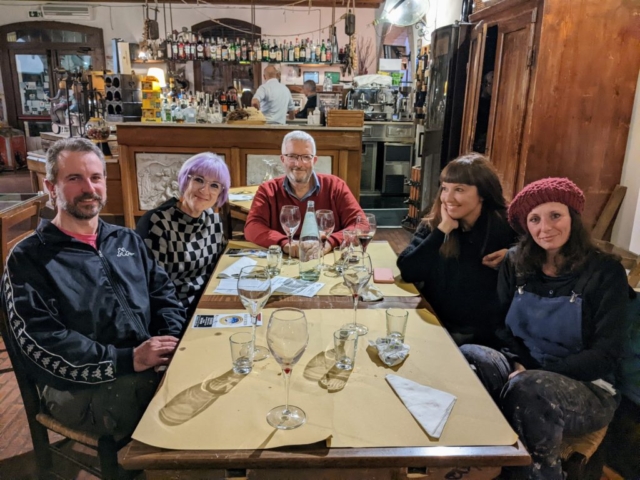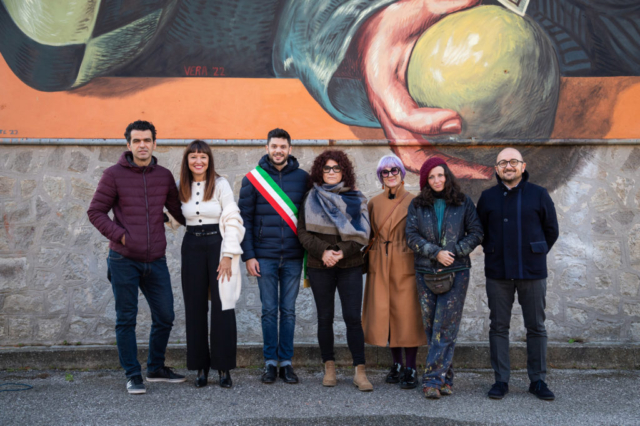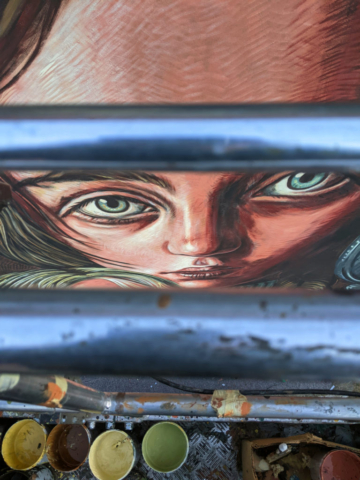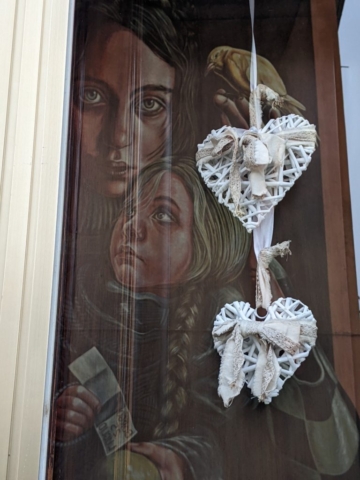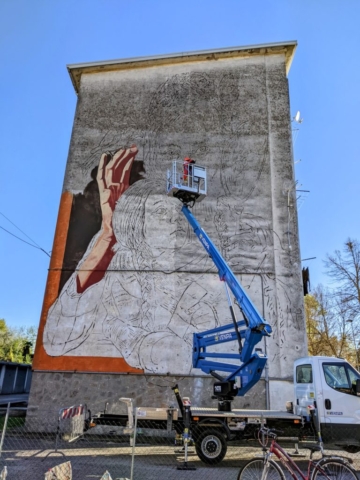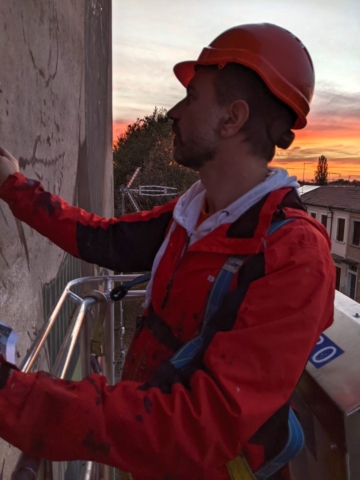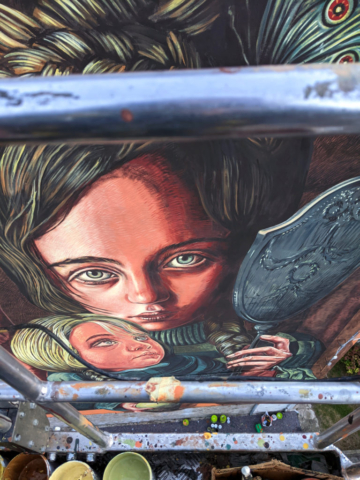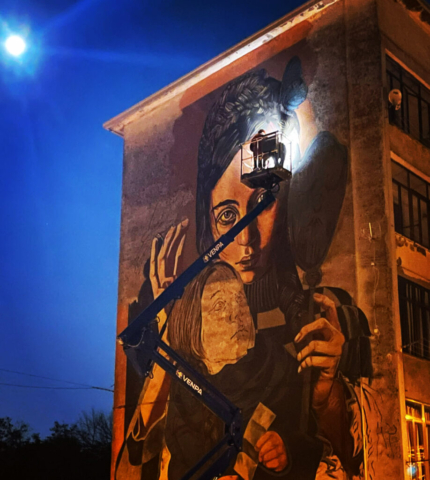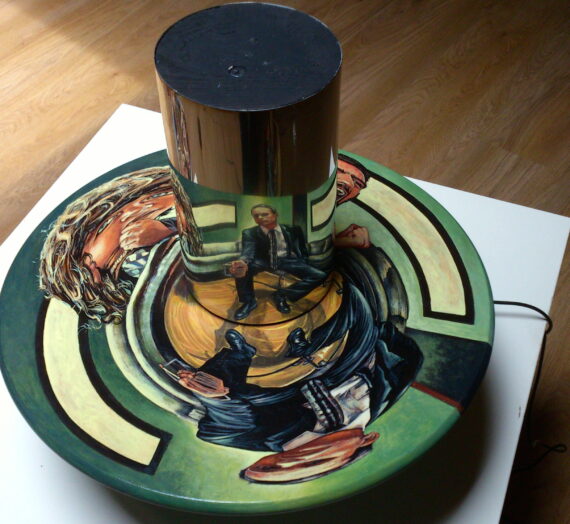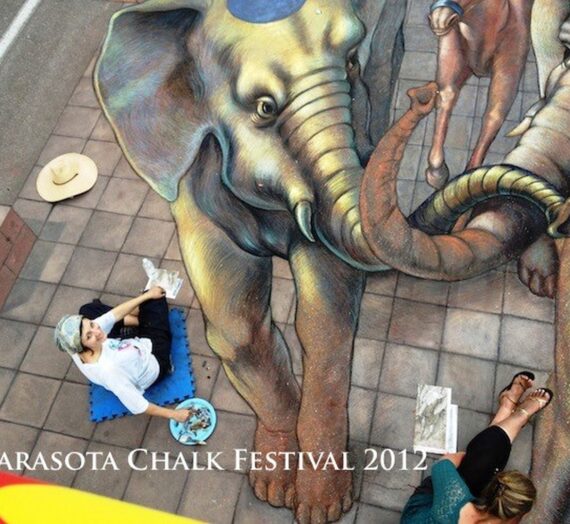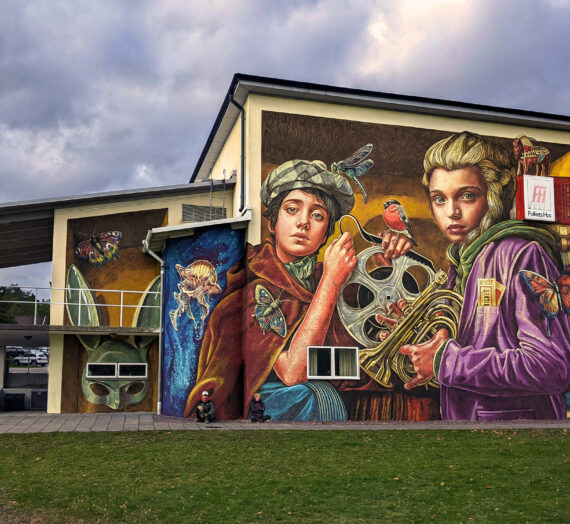Rieccomi, sempre trafelata, tentando di serbare i più bei ricordi di ogni esperienza su parete. Meglio raccontarli quando sono ancora vivide emozioni che attendere troppo quindi colgo il benedetto kairos e provo a parlarvi della mia ultima opera, “Riflettere ancora”.
Realizzata ad Adria nel mese di novembre 2022 all’interno del festival d’arte urbana Deltarte (decima edizione), su una parete di 10×16 metri, è dedicata al tema delle unicità/diversità.
Melania Ruggini, la curatrice del progetto, mi aveva contattata prima dell’estate e avrei dovuto lavorare su piattaforma in ottobre ma mi sono trovata a letto col covid, ko per due settimane. Così sono partita che era già novembre, con le giornate corte e umide, giusto al primo giungere di temporali e aria fredda.
Eppure sono stata scaldata dall’accoglienza ricevuta, cosa non scontata, anzi.
Borgo XXV Luglio: un quartiere popolare complesso, mi era stato riferito, difficile, e un edificio di quattro piani quasi fatiscente. Una zona un po’ abbandonata che meriterebbe attenzione da molti punti di vista e spero che Ater e Comune si prendano cura realmente di alcune problematiche edilizie e gestionali oltre che delle persone che abitano il quartiere.
Qualcuno mi ha detto che lo chiamavano Alcatraz.
Invece i residenti sono stati super, mi hanno accolta, ristorata, hanno portato doni e raccontato le loro storie facendomi sentire a casa. Si preoccupavano perché arrivavo in bicicletta alle 6.45 e poi restavo fino alle 20 a lavorare con un faretto legato al cestello della piattaforma aerea. Alla fine quando ho terminato (giusto all’ora dell’inaugurazione), trovandomeli davanti col sorriso, mi sono commossa e non sapevo dove nascondere il volto paonazzo. Non gli lasciavo molto in fondo, i problemi restavano lì, eppure erano solidali con ciò che avevo realizzato, e col suo messaggio. Quindi ho provato a spiegare ufficialmente l’opera, con la voce un po’ strozzata.
Questa è la poetica che avevo scritto dopo la creazione del bozzetto, è certamente meglio scritta rispetto a ciò che ho tentato di raccontare a parole, eppure forse sono stata più efficace di persona, una volta tanto, chissà.
Servono anni per accettare completamente la nostra unicità come risorsa.
È risaputo quanto sia confortante il sentirsi simili agli altri, una panacea. Per certi aspetti in fondo la diversità non esclude la somiglianza ma spesso si rifugge dal primo aspetto per adagiarsi in una zona confortevole e stereotipata, che mette meno in gioco.
L’omologazione culturale e la difficoltà di reperire modelli identitari di riferimento rappresentano però fattori di disagio psico-relazionale, soprattutto negli adolescenti. Lo standard snatura e forza l’essenza della persona mentre l’unicità autentica rende possibile l’arricchimento reciproco e fa nascere sinergie.
Nell’opera campeggiano due figure femminili, incassate in uno spazio angusto. Al centro una giovane donna con uno specchio in mano e lo sguardo titubante diretto all’osservatore. In primo piano una bambina con una vecchia sciarpa, intenta a osservare lo specchio e i suoi riflessi. In alto un canarino posato sulle dita della donna, anch’esso incuriosito (ma disorientato!) dallo specchio, in basso una mela e un biglietto, fra le mani della bambina.
Le due figure potrebbero essere la stessa persona in fondo, in due fasi della vita. Nello specchio la chiave di lettura. Chi vediamo realmente attraverso vari e multiformi schermi riflettenti?
Se l’apparenza continua ad essere schiavitù (soprattutto femminile) cosa resta davvero delle nostre unicità? Cosa è sinceramente profondo, se il contenuto diventa un’eco flebile dell’immagine?
Riflettere in fondo ha molteplici significati: è rimandare indietro la luce ma anche costituire una ripercussione, una conseguenza o un effetto, medesimamente continuare, essere l’esito, rivolgere la mente su un oggetto del pensiero e soprattutto riconsiderarlo con attenzione.
Nella mela un simbolo plurisignificante di redenzione e perdizione, spiritualità e vanità ma anche memoria di un tempo di difficoltà economiche e sacrifici che segnò il luogo che ospita la mia opera. Il foglietto fra le mani della bimba rimanda infatti al quartiere popolare sorto lungo l’antica strada arginale detta Cengiaretto, che nel 1943, in seguito alla caduta del fascismo, fu rinominato Borgo XXV luglio. La vicenda mi ha fatto ripensare alla libertà riconquistata con la liberazione che era anche possibilità di dissentire, di esprimere opinioni diverse da quelle di un regime, diritto mai scontato e che spesso rischiamo di sottovalutare.
Se avessi realizzato il bozzetto con un paio di settimane di ritardo probabilmente avrei dipinto un pezzo ispirato dalle proteste scoppiate in Iran dopo l’uccisione di Mahsa Amini e Hadith Najafi.
La mia opera voleva essere una riflessione etica sulla unicità. Eppure, credo che un filo leghi accettazione di sé e dell’altro e parità di diritti a tutti i livelli, contro ogni regime o stato repressivo.
Vorrei quindi dedicare questo pezzo alle donne iraniane e al loro coraggio (ne avessi un briciolo) ma anche agli uomini che le stanno appoggiando.
Grazie ancora una volta Fabio Fedele per avermi raggiunta e aiutata alcuni pomeriggi dando come sempre il meglio di sé per consentirmi di terminare in dieci giorni, mission impossible.
Ringrazio poi Melania Ruggini di Deltarte, Remzi Doci presidente dell’Associazione ArtFlood, il Comune di Adria, gli sponsor – Iccio della Farmacia dei Sani e Roberto & Cristina di Adria BnB -, Venpa per la piattaforma, Greta, Sara e Roberta.
Infine un grazie immenso al quartiere, ad Agnese, Matteo e Alessandra, Nicola, Anna, Susy e tutti gli altri, impossibile nominare tutti!
Le fotografie sono di Andrea Zampatti 🙂
https://www.youtube.com/shorts/qyKhMfmMM_E
Here I am again, still out of breath, trying to keep the best memories of every experience on the wall. Better to tell them when they are still vivid emotions than waiting too long so I take the blessed kairos and try to tell you about my latest work, “Reflecting Again”.
Made in Adria (Italy) in November 2022 within the Deltarte urban art festival (tenth edition), on a 10×16 meter wall, it is dedicated to the theme of uniqueness/diversity.
Melania Ruggini, the curator of the project, had contacted me before the summer and I was supposed to work on the platform in October but I found myself in bed with covid, knocked out for two weeks. So I left when it was already November, with short and humid days, just at the first arrival of storms and cold air.
Yet I was warmed by the welcome I received, which is not a foregone conclusion, on the contrary.
Borgo XXV Luglio: a complex popular neighborhood, I was told, difficult, and an almost dilapidated four-story building. A somewhat abandoned area that deserves attention from many points of view and I hope that Ater and the Municipality really take care of some building and management problems as well as the people who live in the neighborhood.
Someone told me they called it Alcatraz.
Instead, the residents were super, they welcomed me, refreshed me, brought gifts and told their stories, making me feel at home. They worried because I arrived by bicycle at 6.45 and then stayed until 8 pm working with a spotlight tied to the basket of the aerial platform. In the end when I finished (just at the time of the inauguration), finding them in front of me with a smile, I was moved and didn’t know where to hide my red face. I didn’t leave him much after all, the problems remained there, yet they were in solidarity with what I had achieved, and with his message. So I tried to officially explain the work, with a bit of a choked voice.
This is the poetics I wrote after the creation of the sketch, it is certainly better written than what I tried to tell in words, yet perhaps I was more effective in person, for once, who knows!
It takes years to fully accept our uniqueness as an asset.
It is known how comforting it is to feel similar to others, a panacea. In some ways, after all, diversity does not exclude similarity, but we often shy away from the first aspect to settle down in a comfortable and stereotyped area, which puts less at stake.
However, cultural homogenization and the difficulty of finding reference identity models represent factors of psycho-relational discomfort, especially in adolescents. The standard distorts and forces the essence of the person while authentic uniqueness makes mutual enrichment possible and gives rise to synergies.
Two female figures stand out in the work, set in a narrow space. In the center a young woman with a mirror in her hand and a hesitant gaze directed at the observer. In the foreground, a little girl with an old scarf, intent on observing the mirror and her reflections. Above a canary placed on the fingers of the woman, also intrigued (but disoriented!) by her mirror, below an apple and a note, in the hands of the little girl.
The two figures could be basically the same person, in two stages of life. In the mirror the reading key. Who do we really see through various and multifarious reflective screens?
If appearance continues to be slavery (especially female) what really remains of our uniqueness? What is truly profound if the content becomes a faint echo of the image?
After all, reflecting has multiple meanings: it is to send the light back but also to constitute a repercussion, a consequence or an effect, at the same time to continue, to be the outcome, to turn the mind on an object of thought and above all to reconsider it carefully.
In the apple a multi-significant symbol of redemption and perdition, spirituality and vanity but also the memory of a time of economic difficulties and sacrifices that marked the place that houses my work. The leaflet in the hands of the little girl refers in fact to the popular neighborhood built along the ancient bank road called Cengiaretto, which in 1943, following the fall of fascism, was renamed Borgo XXV July. The story made me rethink the freedom regained with liberation which was also the possibility of disagreeing, of expressing opinions different from those of a regime, a right that is never taken for granted and which we often risk underestimating.
If I had made the sketch a couple of weeks late I probably would have painted a piece inspired by the protests that erupted in Iran after the killing of Mahsa Amini and Hadith Najafi.
My work wanted to be an ethical reflection on uniqueness. And yet, I believe that a thread links acceptance of self and of the other and equal rights at all levels, against any repressive regime or state.
I would therefore like to dedicate this piece to Iranian women and their courage (if I had a shred of it) but also to the men who are supporting them.
Thanks once again Fabio Fedele for reaching out and helping me a few afternoons, giving his best as always to allow me to finish this mission impossible in ten days.
I then thank Melania Ruggini of Deltarte, Remzi Doci president of the ArtFlood Association, the Municipality of Adria, the sponsors – Iccio of the Farmacia dei Sani and Roberto & Cristina of Adria BnB -, Venpa for the platform, Greta, Sara and Roberta.
Finally, a huge thank you to the neighborhood, to Agnese, Matteo and Alessandra, Nicola, Anna, Susy and all the others, impossible to name everyone!
The photographs are by Andrea Zampatti 🙂
